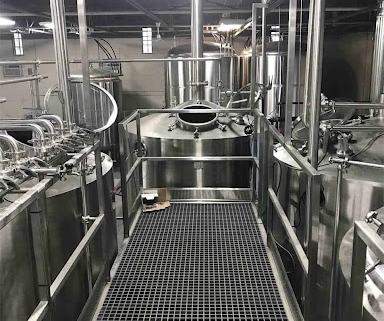How to Start a Microbrewery
Benefits of Microbrewery Systems
Imagine walking into a cozy taproom where the air smells like malt and hops, and the beer in your hand was brewed just a few feet away. That, my friend, is the magic of microbreweries. Microbrewery systems aren’t just for hipsters or hobbyists anymore. These systems offer real, tangible benefits for entrepreneurs, restaurateurs, and even communities.
First off, there’s the flexibility and creativity. Unlike massive commercial breweries that stick to strict recipes for mass appeal, microbreweries give you the freedom to experiment. Want to infuse your IPA with jalapeños or age a stout in bourbon barrels? Go for it. Microbrewery systems let you become the artist of your own beer canvas.
Then there’s the local economic impact. Microbreweries often source ingredients locally and create jobs within the community. They become social hubs that boost tourism and foot traffic for nearby businesses. Plus, people love supporting local. There’s a certain pride in drinking something brewed in your hometown.
On the technical side, microbrewery systems are designed for scalability. Start small with a few hundred liters per batch, then scale up as demand grows. The upfront investment is significantly lower compared to industrial setups, making it accessible for small business owners. And let’s not forget the environmental impact: many microbreweries implement sustainable practices like water recycling and renewable energy use.
Key Components of a Microbrewery System
If you’re picturing just a few barrels and some hops in a shed, think again. A modern microbrewery system is a finely tuned orchestra of stainless steel, sensors, and skilled hands. Let’s break down what goes into the heart of your brewing operation.
At the center of it all is the brewhouse, usually consisting of a mash tun, lauter tun, kettle, and whirlpool. This is where the alchemy happens—transforming grain into wort, the sweet liquid that will one day become beer. Size and design vary, but most microbreweries use systems ranging from 3 to 20 barrels.
Next, we have the fermentation tanks, often conical in shape, which allow the yeast to do its job and sugars to convert into alcohol. These are usually jacketed for temperature control, a must-have for brewing consistency.
Then there’s the cooling system, which brings your hot wort down to yeast-friendly temperatures quickly and safely. Glycol chillers are commonly used here, circulating cold liquid around the fermentation tanks.
You’ll also need a clean-in-place (CIP) system for maintaining hygiene standards. Trust me, beer lovers can taste the difference between clean and contaminated.
Finally, the packaging and dispensing equipment: whether you’re bottling, canning, or kegging, your microbrewery system should integrate with your distribution model. Add a taproom, and you’ll need a draft system too.
Choosing the Right Size and Configuration
This is where things get real. Choosing the right microbrewery size and layout can be the difference between beer bliss and business bust.
Think about your production goals first. Are you aiming to serve your bar and a few local restaurants? Or do you plan to distribute regionally? Small-scale systems, like 3-5 BBL (barrel) systems, are ideal for brewpubs or startups with limited space and budget. They’re compact and manageable, but you’ll need to brew more frequently.
On the flip side, a 10-20 BBL setup can support moderate distribution and offers better economy of scale. You’ll brew less often but produce more per batch, reducing labor and ingredient costs per liter.
The layout matters too. Linear configurations work well in narrow spaces, while circular or U-shaped designs are better for efficiency and worker flow in wider areas. Don’t forget space for storage, packaging, a lab (if you’re going high-end), and customer areas if you have a taproom.
Also, consider automation vs manual systems. Automated systems save time and reduce errors but are more expensive upfront. Manual systems require more labor but offer greater control and lower cost.
Turnkey Microbrewery Systems Compared to Custom-built Systems
| Feature | Turnkey Microbrewery Systems | Custom-built Microbrewery Systems |
|---|---|---|
| Installation Time | Faster (plug-and-play setup) | Slower (requires custom fitting) |
| Cost | Generally lower | Typically higher due to customization |
| Design Flexibility | Limited to pre-set options | Highly flexible, tailored to your needs |
| Support & Warranty | Often includes full support | Depends on the builder or integrator |
| Scalability | Moderate | High if designed with expansion in mind |
| Best For | First-time brewers, startups | Experienced brewers, unique spaces |
Turnkey systems are like buying a ready-made kitchen. You get what you see—fast setup, minimal hassle. But if you have unique space constraints, specific brewing techniques, or future scaling plans, custom-built might be your best bet. Just be ready for a longer lead time and a higher price tag.
Cost Breakdown and ROI (Return on Investment)
Let’s talk money. Opening a microbrewery isn’t cheap, but it can be one heck of an investment if done right.
Costs vary widely based on size, location, and ambition. Here’s a rough idea:
| Cost Category | Estimated Range |
|---|---|
| Equipment (5-10 BBL system) | $100,000 – $500,000 |
| Building/Renovation | $50,000 – $200,000 |
| Licensing & Legal | $5,000 – $20,000 |
| Raw Materials (first 6 months) | $10,000 – $50,000 |
| Staff & Training | $20,000 – $100,000 |
| Marketing & Branding | $5,000 – $30,000 |
So yeah, you might be looking at a total startup cost of $200K to $900K. But what about the returns?
With a solid product and smart marketing, many microbreweries see ROI within 2-3 years. Taprooms have higher margins than wholesale, so if you can sell directly to customers, your break-even point comes quicker. Limited-edition releases, merchandise, and food service can add to your revenue stream too.
Installation and Technical Support for Microbrewery Systems
Even the best microbrewery system can turn into a nightmare if it’s not installed properly. That’s why having experienced technicians is crucial.
Turnkey systems often come with on-site installation and calibration. The supplier handles plumbing, electrical, and system checks. They’ll also train your team on daily operation and basic troubleshooting. Custom systems might require coordination between multiple vendors, which means more oversight but also more room for customization.
Post-installation, look for companies that offer 24/7 technical support. Brewing is a 24/7 business, and you don’t want a stuck valve or a software bug holding up a batch. Some suppliers even offer remote monitoring so they can diagnose issues in real-time.
Compliance and Safety Standards in Microbrewing
Beer might be fun, but brewing is serious business when it comes to compliance and safety.
First off, you’ll need to navigate federal, state, and local regulations. In the U.S., that includes TTB (Alcohol and Tobacco Tax and Trade Bureau) licensing, FDA regulations, and local health and zoning approvals.
Your equipment needs to meet food-grade and sanitary standards, usually certified by bodies like the NSF. Electrical systems should comply with UL standards, and pressure vessels must meet ASME codes.
Also important: worker safety. Brewery floors get slippery, equipment gets hot, and chemicals can be hazardous. Proper PPE (Personal Protective Equipment), safety training, and signage are must-haves. Insurance isn’t just smart—it’s often required.
Microbrewery Success Story: A Real-World Example
Let me tell you about “Hoppy Trails Brewing Co.,” a tiny operation that started in a garage in Oregon.
Back in 2018, the founder, Lisa, took a gamble. She bought a 5 BBL turnkey system with her savings and set up shop in an old bakery. The community loved her inventive flavors, from lavender-infused saisons to Thai chili stouts. She started with a taproom-only model, keeping overhead low.
Word got around. Within 18 months, she upgraded to a 10 BBL system and began distributing to local restaurants. She reinvested profits into a canning line, expanded staff, and added a beer garden. By year three, she was pulling six figures in profit and had a waiting list of investors.
Her secret? Start small. Brew boldly. Stay local. And always, always clean your lines.
FAQs
| Question | Answer |
|---|---|
| What is the minimum size for a microbrewery system? | Most microbreweries start with systems between 3 to 5 BBL. |
| How long does it take to set up a microbrewery? | Typically 3-6 months including permits, construction, and installation. |
| Do I need a license to operate a microbrewery? | Yes. You’ll need federal, state, and local licenses. |
| What is the shelf life of microbrewed beer? | Depends on style and packaging, but typically 3-6 months for most. |
| Can I start a microbrewery at home? | Legally, only for personal use. Commercial sales require proper licensing. |
| How many staff are needed to run a microbrewery? | A small operation can start with 2-5 people, scaling as needed. |
| Is brewing beer profitable? | Yes, with good planning and market research, many see profits within 2-3 years. |




